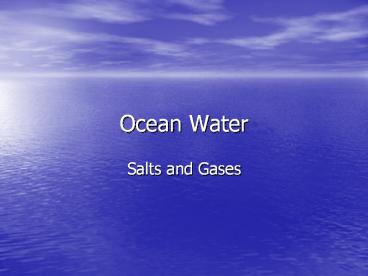Ocean Water - PowerPoint PPT Presentation
1 / 21
Title:
Ocean Water
Description:
Ocean Water Salts and Gases The Dissolving Power of Water Dissolving power results from polar nature of H2O molecule Salinity in Oceans Salinity Constituents of Sea ... – PowerPoint PPT presentation
Number of Views:69
Avg rating:3.0/5.0
Title: Ocean Water
1
Ocean Water
- Salts and Gases
2
The Dissolving Power of Water
- Dissolving power results from polar nature of H2O
molecule
- Na and Cl- are held together by ionic bonds
(attraction of opposite charges)
- H2O reduces the ionic bonding and pulls Na and
Cl- apart
3
Salinity in Oceans
- Salinity
- Total amount of dissolved solids expressed in
grams in 1 kg of water
- Average salinity in oceans 35
- 35 parts per thousand (ppt)
- 35 g/kg
- Salinity variations
- Due to differences in local rates of evaporation
and precipitation (water budget)
4
Constituents of Sea Water
- Most abundant seawater elements are sodium (Na)
chloride (Cl-)
- Major constituents SO42-, Mg2, Ca2, K, and
HCO3-
- Minor and trace elements also present
5
Seawater versus River Water
Chemical Constituent Percent of total salt content Percent of total salt content
Chemical Constituent Ocean River
Silica (SiO2) Iron (Fe) Calcium (Ca) Magnesium (Mg) Sodium (Na) Potassium (K) Bicarbonate (HCO3) Sulfate (SO42-) Chloride (Cl) Nitrate (NO3) Bromide (Br) TOTAL - - 1.19 3.72 30.53 1.11 0.42 7.67 55.16 - .02 100.00 14.51 0.74 16.62 4.54 6.98 2.55 31.90 12.41 8.64 1.11 - 100.00
6
Salts in the Ocean
Why is the ocean salty?
Chemical Constituent Percent of total salt content Percent of total salt content
Chemical Constituent Ocean River
Silica (SiO2) Iron (Fe) Calcium (Ca) Magnesium (Mg) Sodium (Na) Potassium (K) Bicarbonate (HCO3) Sulfate (SO42-) Chloride (Cl) Nitrate (NO3) Bromide (Br) TOTAL - - 1.19 3.72 30.53 1.11 0.42 7.67 55.16 - .02 100.00 14.51 0.74 16.62 4.54 6.98 2.55 31.90 12.41 8.64 1.11 - 100.00
- Salts come from
- Rocks cations
- Gases from mantle anions
- Why is the ocean not getting saltier?
- Salts going in salts going out
7
Salts Going Out
- Sea Sra
- Sea Spray
- Evaporites
- Biological
- Fecal pellets
- Shell formation
- Adsorption
- Mid-ocean ridge magma
8
Principle of Constant Proportions
- The amount of salt varies, but the relative
proportions of ions are constant
- Because of this principle, it is necessary to
test for 1 salt ion (usually Cl) to determine
total amount of salt present
9
Determining Salinity
- 1. Calculating Salinity
- Salinity1.8065 x chlorinity ()
2. Salinometers
- Salinity determined by the electrical
conductivity produced by dissolved salts
10
Factors Affecting Salinity
- Precipitation
- Evaporation
- River runoff
- Freezing
11
Residence Times
- Average length in time that a substance remains
in solution in seawater
Ion Time in years
Chloride (Cl-) Sodium (Na) Magnesium (Mg2) Sulfate (SO42-) Potassium (K) Calcium (Ca) Manganese (Mn) Aluminum (Al) Iron (Fe) 80 million 60 million 10 million 9 million 6 million 1 million 7 thousand 1 hundred 1 hundred
- Ions with longer residence times are most
abundant in ocean
12
Effects of Salinity
- Freezing point depression boiling point elevation
- Disrupts Hydrogen bonding
- (freezing point of seawater -2C)
2. Changes density
- Pure water density 1 kg/l
- Seawater density 1.024 kg/l
3. Changes vapor pressure
- ? , ? P
13
Desalination
- Fresh H20 from Salt H20
- Methods
- Distillation
- Electrodialysis
- Reverse Osmosis
14
Gases
15
Gases in Seawater
- Major Gases N2, O2 and CO2
- O2 and CO2 important for life processes
16
CO2 and O2 with depth
- Surface (0m)
- Oxygen (O2) abundant gas
- Photosynthesis dominant
- 200m - 1,000m
- Oxygen (O2) ?
- Carbon Dioxide (CO2) ?
- Respiration dominant
- Organic matter decay
- 1,000m 4,000m
- O2 ? slightly
- Oxygenated bottom waters
- Cold salty oxygenated H2O sinks in polar region
transported to depth
- CO2 continues to ?
- Organic matter decay
17
GasesSummary
- Photosynthesis
- CO2 consumed O2 produced
- Therefore, O2 more abundant than CO2 in photic
zone
- Respiration
- O2 consumed CO2 produced
- Organic matter (OM) decay
- O2 consumed CO2 produced
- Respiration and OM decay
- ? CO2 below photic zone
18
The pH Scale
- An acid has excess H (Hydrogen ions)
- A base has excess OH- (Hydroxyl ions)
- CO2 controls acidity
- ? CO2 ? acidity
- ? CO2 ? acidity
pH of seawater 7.5-8.5 Average 8.0
19
Gases in SeawaterCarbonate Buffering System
- Dissolved CO2 in water acts as a buffer
- Prevents large shifts in pH
- Seawater too basic
- H2CO3 ? HCO3- H (pH drops)
- Seawater too acidic
- HCO3- H ? H2CO3 (pH rises)
20
Gas Cycling
- O2 Cycling
- Photosynthesis produce O2
- Respiration decomposition of O.M. use O2
- O.M. buried doesnt consume all O2
- Rocks consume O2
- CO2 Cycling
- Organisms use CO2 for tissue
- Decay of O.M. releases CO2 back to ocean
21
Nutrients and Organics
- Required for plant growth
- Cycled by plant growth and decay
- Organics used by organism or buried































